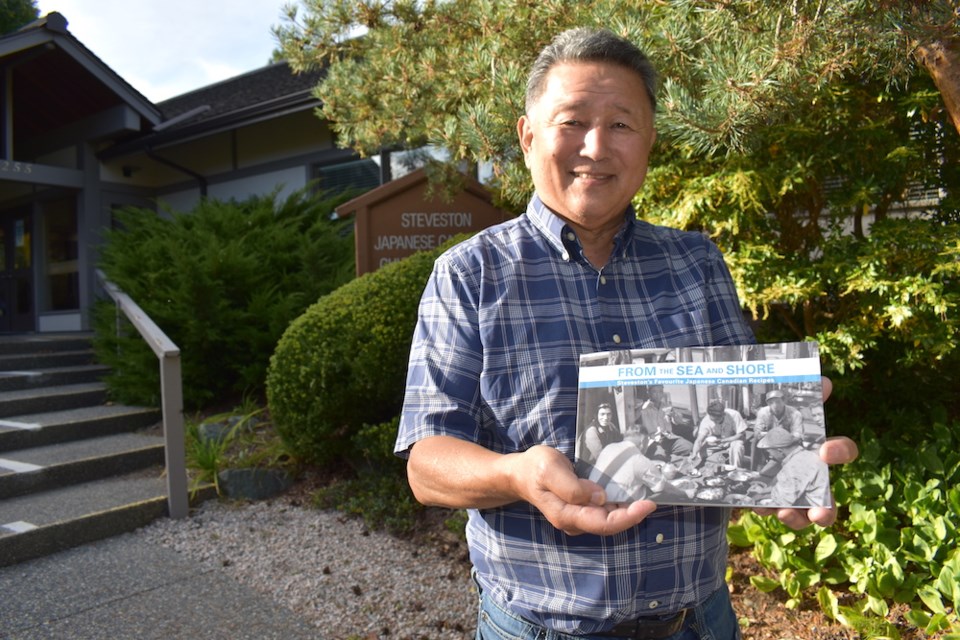In the mid-20th century, Japanese mothers and grandmothers started cooking at 5 a.m. for Kendo competitions in Steveston and finished up at midnight after everything was cleaned up.
They were long days cooking meals for participants and attendees.
But through the grapevine at the Martial Arts Centre, the women would find out when their son or grandson was competing and they’d hurry to the competition hall to catch sight of the tournament.
But then it was back to the kitchen.
This was the way it was in the 1950s and 1960s in Steveston with women sweating over hot stoves at home and at community events.
While it might seem patriarchal, the Kendo competitions and the amazing traditional food cooked by Japanese women and served during them are part of the history of the Japanese in Steveston, explained Kelvin Higo, who has just helped write a book with recipes from the Steveston-Japanese community.
The book is dedicated to “the Steveston Japanese Canadian mothers, grandmothers and great-grandmothers whose resilience is the foundation of our Steveston community.”
From the Sea and Shore: Steveston’s Favourite Japanese Canadian Recipes was a labour of love for Higo, who, especially since his retirement, has been volunteering with the Japanese community to collect and promote local Japanese history and culture.
Higo spent a lot of time talking to the elders in the Steveston Japanese community to collect anecdotes and recipes for the book.
He wanted to get the recipes from them before they were lost – especially since they hadn’t written them down, rather it was done by taste.
“They would say, well, you just add a little bit of this and a little bit of that,” Higo said. “I said, I can’t put that in the recipe because it would be a very short book.”
Higo’s wife Kay kitchen-tested the recipes in the book and his father-in-law Toshio Murao taste-tested them, to make sure they had the right “aji” – taste.
Since Japanese immigrants to Steveston came from many different areas, prefectures, in Japan, the cookbook reflects a variety of cooking styles.
The book is an amalgamation of these traditional recipes but it’s also meant to evoke memories.
“Food culture is a great unifier,” Higo said, pointing to events like the annual bazaar at the Steveston Buddhist Temple where food was served. “Food draws people together and you get to see people you haven’t seen all year. I think this applies to any culture.”
The cookbook is divided into seasons, because that’s how food was prepared by the Japanese community – by those on their fishing boats and those living in the Village of Steveston.
While some people comment that there is a lot of salt and sugar in the recipes, Higo pointed out the early Japanese community had very little refrigeration for their food, so fish needed to be preserved by salting.
It wasn’t until the Steveston Frozen Food Locker Plant was opened that fishermen could freeze their fish for the winter – in what Higo calls a “bank” from which they could "withdraw" a salmon.
The cookbook contains 65 recipes, many of which integrate ingredients from Steveston, like salmon, but are based on traditional Japanese cooking. It includes the well-known chow mein recipe that is served at the annual Steveston Salmon Festival.
There’s also a recipe for bologne and cabbage – because cabbage was one of those ingredients that kept well on a boat without a fridge.
“It’s a silly recipe but as soon as I put it in everybody said, ‘I remember this,’” Higo said.
Some of the recipes feature “fuki,” a bog rhubarb that Japanese immigrants brought to Steveston and grew here.
Patches can still be found in Steveston, Higo said, for example, along the greenway leading from McMath secondary to Railway, and some old-timers still have it growing in their yards.
The cookbook was made through a partnership between Tonari Gumi and the Steveston Japanese Canadian Cultural Centre and was funded by a New Horizons grant.
The book is the third in a series highlighting Japanese history and culture. Previously, Tonari Gumi, the Japanese Community Volunteer Association, has published Home Away from Home and Our Edible Roots.
The history of the Japanese in Steveston deserves to be “told and retold,” Higo said, and this latest book is part of this effort.
Higo called Steveston the “epicentre” of where the injustices towards Japanese took place during the Second World War, including the seizure of dozens of fishing boats and properties and the placement of 2,000 Japanese Stevestonites in internment camps.
Despite how they were treated during the war, many Japanese people came back to Steveston, when they were allowed to in 1949, and they picked up where they left off to rebuild their lives, many again earning a living from the sea.
They also gave back to the community, fundraising and building the first community centre in Richmond, the martial arts centre and the Buddhist temple.
Higo admires his forebearers’ dedication to contributing to Canadian society even after how they were treated during the war.
Higo does walking history tours of Steveston and he often tells participants, “I don’t know if I could have been a big enough man to forgive that easily.”
Last spring, the Steveston Japanese Canadian Cultural Centre held two Zoom cooking classes and they plan to hold four more this fall to teach the next generations how to cook traditional Japanese food.
From the Sea and Shore is $20+GST and copies are for sale at the Gulf of Georgia Cannery. All proceeds will go towards seniors programs at the Steveston Japanese Cultural Centre.



